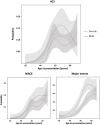Telephone triage of chest pain in out-of-hours primary care: external validation of a symptom-based prediction rule to rule out acute coronary syndromes
- PMID: 38801727
- PMCID: PMC11461144
- DOI: 10.1093/fampra/cmae028
Telephone triage of chest pain in out-of-hours primary care: external validation of a symptom-based prediction rule to rule out acute coronary syndromes
Abstract
Introduction: Telephone triage is pivotal for evaluating the urgency of patient care, and in the Netherlands, the Netherlands Triage Standard (NTS) demonstrates moderate discrimination for chest pain. To address this, the Safety First Prediction Rule (SFPR) was developed to improve the safety of ruling out acute coronary syndrome (ACS) during telephone triage.
Methods: We conducted an external validation of the SFPR using data from the TRACE study, a retrospective cohort study in out-of-hours primary care. We evaluated the diagnostic accuracy assessment for ACS, major adverse cardiovascular events (MACE), and major events within 6 weeks. Moreover, we compared its performance with that of the NTS algorithm.
Results: Among 1404 included patients (57.3% female, 6.8% ACS, 8.6% MACE), the SFPR demonstrated good discrimination for ACS (C-statistic: 0.79; 95%-CI: 0.75-0.83) and MACE (C-statistic: 0.79; 95%-CI: 0.0.76-0.82). Calibration was satisfactory, with overestimation observed in high-risk patients for ACS. The SFPR (risk threshold 2.5%) trended toward higher sensitivity (95.8% vs. 86.3%) and negative predictive value (99.3% vs. 97.6%) with a lower negative likelihood ratio (0.10 vs. 0.34) than the NTS algorithm.
Conclusion: The SFPR proved robust for risk stratification in patients with acute chest pain seeking out-of-hours primary care in the Netherlands. Further prospective validation and implementation are warranted to refine and establish the rule's clinical utility.
Keywords: acute coronary syndrome; chest pain; clinical prediction rule; primary care.
© The Author(s) 2024. Published by Oxford University Press.
Conflict of interest statement
None declared.
Figures




Similar articles
-
Evaluation of telephone triage among chest pain patients in out-of-hours primary care in the Netherlands (TRACE).Fam Pract. 2023 Feb 9;40(1):23-29. doi: 10.1093/fampra/cmac077. Fam Pract. 2023. PMID: 35849343 Free PMC article.
-
Optimisation of telephone triage of callers with symptoms suggestive of acute cardiovascular disease in out-of-hours primary care: observational design of the Safety First study.BMJ Open. 2019 Jul 1;9(7):e027477. doi: 10.1136/bmjopen-2018-027477. BMJ Open. 2019. PMID: 31266836 Free PMC article.
-
Assessing sensitivity and specificity of the Manchester Triage System in the evaluation of acute coronary syndrome in adult patients in emergency care: a systematic review protocol.JBI Database System Rev Implement Rep. 2015 Nov;13(11):64-73. doi: 10.11124/jbisrir-2015-2213. JBI Database System Rev Implement Rep. 2015. PMID: 26657465
-
Accuracy of emergency medical services (EMS) telephone triage in identifying acute coronary syndrome (ACS) for patients with chest pain: a systematic literature review.BMJ Open. 2021 Aug 25;11(8):e045815. doi: 10.1136/bmjopen-2020-045815. BMJ Open. 2021. PMID: 34433592 Free PMC article.
-
Chest Pain in Primary Care: A Systematic Review of Risk Stratification Tools to Rule Out Acute Coronary Syndrome.Ann Fam Med. 2024 Sep-Oct;22(5):426-436. doi: 10.1370/afm.3141. Ann Fam Med. 2024. PMID: 39313342 Free PMC article.
References
-
- Netherlands Triage Standard 2023. http://de-nts.nl/. Date accessed 29 December 2023.
Publication types
MeSH terms
Grants and funding
LinkOut - more resources
Full Text Sources
Medical

